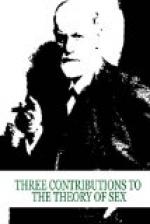In view of all this, the existence of congenital inversion can certainly be questioned. The objection may be made to it that a more accurate examination of those claimed to be congenitally inverted will probably show that the direction of the libido was determined by a definite experience of early childhood, which has not been retained in the conscious memory of the person, but which can be brought back to memory by proper influences (Havelock Ellis). According to that author inversion can be designated only as a frequent variation of the sexual impulse which may be determined by a number of external circumstances of life.
The apparent certainty thus reached is, however, overthrown by the retort that manifestly there are many persons who have experienced even in their early youth those very sexual influences, such as seduction, mutual onanism, without becoming inverts, or without constantly remaining so. Hence, one is forced to assume that the alternatives congenital and acquired are either incomplete or do not cover the circumstances present in inversions.
Explanation of Inversion.—The nature of inversion is explained neither by the assumption that it is congenital nor that it is acquired. In the first case, we need to be told what there is in it of the congenital, unless we are satisfied with the roughest explanation, namely, that a person brings along a congenital sexual impulse connected with a definite sexual object. In the second case it is a question whether the manifold accidental influences suffice to explain the acquisition unless there is something in the individual to meet them half way. The negation of this last factor is inadmissible according to our former conclusions.
The Relation of Bisexuality.—Since the time of Frank Lydston, Kiernan, and Chevalier, a new series of ideas has been introduced for the explanation of the possibility of sexual inversion. This contains a new contradiction to the popular belief which assumes that a human being is either a man or a woman. Science shows cases in which the sexual characteristics appear blurred and thus the sexual distinction is made difficult, especially on an anatomical basis. The genitals of such persons unite the male and female characteristics (hermaphroditism). In rare cases both parts of the sexual apparatus are well developed (true hermaphroditism), but usually both are stunted.[9]
The importance of these abnormalities lies in the fact that they unexpectedly facilitate the understanding of the normal formation. A certain degree of anatomical hermaphroditism really belongs to the normal. In no normally formed male or female are traces of the apparatus of the other sex lacking; these either continue functionless as rudimentary organs, or they are transformed for the purpose of assuming other functions.
The conception which we gather from this long known anatomical fact is the original predisposition to bisexuality, which in the course of development has changed to monosexuality, leaving slight remnants of the stunted sex.




